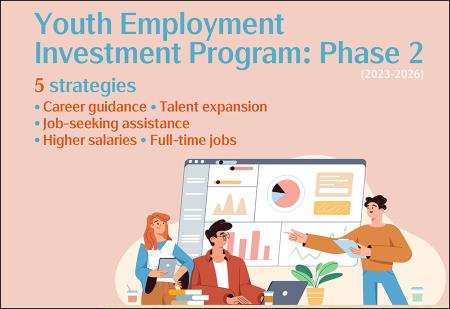Youth Employment Investment Program (Phase 2)
- Publication Date :
- Last updated:2023-06-17
- View count:192

Young people are a vital force for sustainable national growth, reform and innovation. In response to the nation's low birth rate and a shrinking youth workforce, between 2019 and 2022 the government implemented the first phase of a Youth Employment Investment Program. Despite the difficulties of the COVID-19 pandemic, in 2022 the unemployment rate among 15-to-29-year-olds fell to 8.38%, the lowest rate following the global financial crisis of 2008.
Despite this progress, the youth unemployment rate is still more than twice that of the general population, while Taiwan's labor force participation rate for 15-to-24-year-olds is as much as 10 percentage points lower than the average for Organisation for Economic Co-operation and Development (OECD) member countries. In order to respond to future industrial developments and tackle youth unemployment, in May 2023 the government initiated a second phase of the Youth Employment Investment Program (2023 to 2026). Phase two focuses on core issues relating to career development, manpower supply and demand, youth unemployment, youth wages and atypical employment.
Five aims and strategies
■ Strengthen career guidance: Assist young people to clarify their future career direction, understand the various industries, vocations and professions, and improve their ability to adapt to the workplace, such as by strengthening career coaching at colleges and universities, and promoting career exploration, employment counseling and career guidance.
■ Expand talent pool: Review industrial policy priorities and tailor human resource allocation accordingly such as by conducting an inventory of manpower requirements for key industries, assisting young people to enter these industries and promoting the Ministry of Economic Affair's Industry Professional Assessment System.
■ Provide job-seeking assistance: Develop measures to assist first-time jobseekers, such as by encouraging active job searching, guiding young people toward industries with labor shortfalls, monitoring employment flows, mentoring young entrepreneurs, helping disadvantaged groups to find employment and promoting youth-elderly cooperation.
■ Assist attainment of higher salaries: Help young people identify key industries and bridge the skills gap from education to employment, such as by adjusting school departments to meet the manpower requirements of industry, expanding high-quality industrial-academic cooperation, guiding interdisciplinary learning and cultivating digital talent.
■ Smooth transition to full-time employment: Improve job-seeking services and provide career change assistance such as conducting jobseeker training courses, providing workplace learning and re-adaptation opportunities, as well as rewarding employers who provide positions to young members of society.

